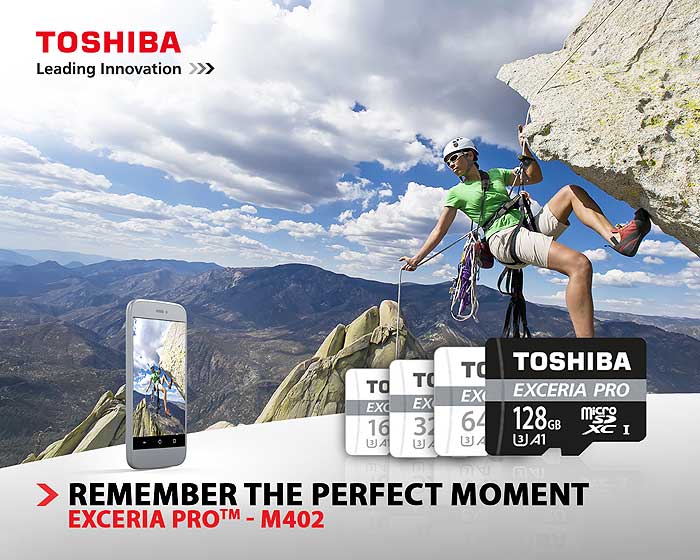 Toshiba Electronics Europe has earned the SD Association’s new Application Performance Class A1 label for its EXCERIA PRO microSDHC/microSDXC M402 memory cards. The cards can bring mobile users the speed needed to keep up with the many demands placed on their devices, while also providing storage of pictures, HD videos, music, documents and other data.
Toshiba Electronics Europe has earned the SD Association’s new Application Performance Class A1 label for its EXCERIA PRO microSDHC/microSDXC M402 memory cards. The cards can bring mobile users the speed needed to keep up with the many demands placed on their devices, while also providing storage of pictures, HD videos, music, documents and other data.
The A1 classification is defined in the latest SD Association card specification 5.1, and specifies at least 1500 random read IOPS (Input-Output access Per Second), 500 random write IOPS and sustained sequential performance of 10MB/s. Toshiba’s microSDHC/microSDXC M402 cards fulfil these requirements and are now labelled as Class A1 memories, letting consumers know – before they buy – that the card can handle[1] tasks they might demand including interfacing to a camera, playing-back HD video and more.
The new cards will reach stores in Q2 CY2017.
The cards are compatible with standard microSD card readers, and come with an adapter that allows use in other devices such as cameras, camcorders, tablets, and laptops or PCs. The cards are also shock resistant confirmed by 5-metre drop test, water resistant up to IPX7, and X-ray resistant up to ISO7816-1 specifications.
Card densities of 16GB, 32GB, 64GB, and 128GB[2] cards allow users to store up to approximately 30,500 high-quality pictures or 1900 minutes of high-quality video[3].
The cards are already UHS Speed Class U3[4] compatible with read and write speeds of up to 95MB/s[5] which will provide high performance for capturing video up to full HD or 4K resolution.
EXCERIA PRO M402 cards are backed by a five-year standard limited warranty and include a data-recovery software coupon.
Notes:
[1] Storing and operation of apps in a card is determined by host device and/or apps.
[2] One Gigabyte (1GB) means 109 = 1,000,000,000 bytes using powers of 10. A computer operating system, however, reports storage capacity using powers of 2 for the definition of 1GB= 230 = 1,073,741,824 bytes and therefore shows less storage capacity. Available storage capacity (including examples of various media files) will vary based on file size, formatting, settings, software and operating system and other factors.
[3] High quality pictures as JPEGs compressed and 12MP and videos of high quality HD resolution of 9Mbps
[4] Read/write data transfer rate based on SD standard. Full HD or 4K video recording operation may vary depending on devices you use and other factors such as file attributes and/or size.
[5] 1 MB/s is calculated as 1,000,000 bytes/s. The maximum transfer speed is the best value obtained under specific conditions in Toshiba’s test environment and Toshiba does not warrant the speed in the equipment to be used. The read/write speed varies depending on the conditions of the equipment to be used. Conventionally, the transfer rate of the SD interface is lower than the UHS-I interface.
* EXCERIA and EXCERIA PRO are trademarks of Toshiba Corporation.
* microSDHC and microSDXC are trademarks of SD-3C LLC.
Toshiba Electronics Europe
www.toshiba-memory.com


